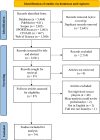The Effects of Strength, Plyometric and Combined Training on Strength, Power and Speed Characteristics in High-Level, Highly Trained Male Youth Soccer Players: A Systematic Review and Meta-Analysis
- PMID: 37897637
- PMCID: PMC10978689
- DOI: 10.1007/s40279-023-01944-8
The Effects of Strength, Plyometric and Combined Training on Strength, Power and Speed Characteristics in High-Level, Highly Trained Male Youth Soccer Players: A Systematic Review and Meta-Analysis
Abstract
Background: Male youth soccer players competing at a high level will typically engage in large volumes of soccer training from a young age. However, it is not known whether the high levels of habitual training that these high-performing players are exposed to limit their ability to respond to strength, plyometric or combined training interventions.
Objective: The primary aim of our systematic review and meta-analysis was to compare the specific effects of strength, plyometric and combined training with active controls (standard soccer training) on the strength, power and speed characteristics of high-level, highly trained young male soccer players.
Methods: We performed a literature search across PubMed, Scopus, CINAHL, Web of Science and SPORTDiscus to identify controlled studies that implemented strength, plyometric or combined training in high-level male youth soccer players. Participants were defined as high level or highly trained based on established guidelines related to either competition level or age-related weekly hours spent in soccer training. Studies needed to report at least one outcome of lower body strength, squat jump, countermovement jump, horizontal power, acceleration (0-10 m), speed (15-40 m) or change of direction speed. A meta-analysis was then performed using a random-effects model to determine the magnitude (Hedge's g) of training responses and whether effects differed across modes of training.
Results: From an initial return of 5464 papers, n = 34 studies met the inclusion criteria and provided a total sample of n = 1396 high-level male youth soccer players. Strength, plyometric and combined training resulted in improvements in strength, squat and countermovement jump, horizontal power, acceleration, change of direction speed (all p < 0.05; g = 0.73-1.08, moderate) and speed (p < 0.05; g = 0.40-0.59, small). Lower body strength was the only outcome where training mode had a significant effect (p < 0.05), with plyometric training producing small effects (g = 0.27, p < 0.05) compared with moderate effects for strength (g = 1.07, p < 0.05) and combined (g = 0.75, p < 0.05) training. Prediction intervals for overall effects (all training modes combined) showed that the greatest confidence that future training will lead to positive effects was in the squat and countermovement jump, horizontal power and acceleration (prediction intervals = 0.03-1.81).
Conclusions: High-level, highly trained male youth soccer players can experience positive gains in indices of strength, power and speed from strength, plyometric and combined training, and the magnitude of gains are mostly similar across modes of training. Based on prediction intervals, there is a good level of certainty that future strength, plyometric and combined training in this population would lead to positive improvements in vertical and horizontal power and sprint acceleration.
© 2023. The Author(s).
Conflict of interest statement
The authors confirm that there are no direct or indirect financial or non-financial conflicts of interests related to the work.
Figures








References
-
- Arnason A, Sigurdsson SB, Gudmundsson A, Holme I, Engebretsen L, Bahr R. Physical fitness, injuries, and team performance in soccer. Med Sci Sports Exerc. 2004;36:278–285. doi: 10.1249/01.MSS.0000113478.92945.CA. - DOI - PubMed
-
- Castillo D, Rodríguez-Fernández A, Nakamura FY, Sanchez-Sanchez J, Ramirez-Campillo R, Yanci J, et al. Influence of different small-sided game formats on physical and physiological demands and physical performance in young soccer players. J Strength Cond Res. 2021;35:2287–2293. doi: 10.1519/JSC.0000000000003114. - DOI - PubMed
Publication types
MeSH terms
LinkOut - more resources
Full Text Sources
Medical
Miscellaneous

